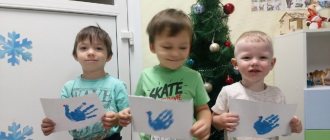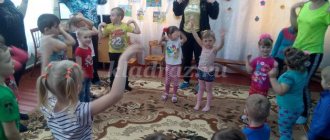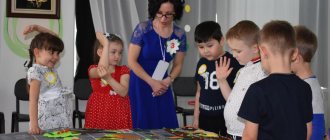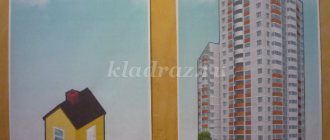Mathematical quest - a game in kindergarten in the senior group
Mathematical quest game “Tricks of the insidious Villain” (lesson notes).
Senior group Goal : creating a social situation for the development of children while solving game search problems. Objectives: 1. Creating conditions for involving each child in an active cognitive process.
2. To promote the development of interest, creativity, imagination of preschool children, search activity, and the desire for novelty; promote tolerance and personal responsibility for doing work. 3. Creating conditions for consolidating the skill of quantitative calculation; Solving arithmetic examples involving addition and subtraction. 4. To promote the development of initial measurement skills in children, to measure the volume of liquid substances using a conventional measure. 5. To promote the development of children’s creative imagination in the process of finding ways to manifest “invisible” ink, using magnets. 6. Improve children’s ability to solve simple arithmetic problems, including addition and subtraction within 10; creating an image of a number from a soft stick. 7. Creation of conditions for the distribution of counting sticks in space in order to obtain the desired image. Progress of the lesson
When airing, the teacher informs the children that today they will have a real surprise, which they have all been waiting for so long.
A container appeared in the group, containing probably 10 boxes of LEGO people, for girls and boys. Offers to go see what's in the container. In the group there is a container locked with a combination lock. There is a letter nearby/an audio recording is heard: “Well, kids, hello everyone. How cool it was to lock your LEGO people with my combination lock! If you want to get little people, then you will have to work hard. You need to find a code for the lock. And this is not at all easy to do! Each digit from the code can be obtained by completing my tasks! I completely forgot, I hid all the tasks too! Look for them using the clues! Here's your first hint! It’s on the third guest’s right.” The children count the third guest on the right and ask him for a hint. Children open the envelope, and there is a white sheet of paper. Educator: Guys, what are we going to do? The villain is just mocking us. We'll probably never figure out the code. What if there really is a clue on this sheet? Children: Maybe this sheet is written in invisible ink? Educator: how to check this? Children's options. The teacher and the children go to the table and use pencils to color the sheet, and the word “Chair” begins to appear on it. Educator: It says “Chair”, so what could it mean? Children: let's examine the chair. They examine the chair and under it they find an envelope containing the task . In front of you lies a tray with buckwheat, your task is to get examples with encrypted letters from the tray, solve the example, find out the serial number of the letter and decipher the word. But the main condition of this task is that you cannot touch the buckwheat, since the villain poisoned it.
(a magnet is glued to each card) / examples by the number of children
Educator: Guys, what do you think, how can we get the cards from the tray without touching the buckwheat? Children's options. Children: Let's use a fishing rod with a nail. Educator: How can this help us? Children: The carnation is attracted by a magnet, so we won’t touch the buckwheat and take out the card. Educator: Let's try. They complete tasks, take out cards, solve examples, put out letters and get the word TABLE. They inspect the table and find 2 envelopes under it - in one there is a flash drive, in the second the number from the code is 1. The children and the teacher agree to add up the numbers from the code in the order they were received, so as not to get confused (next to the container). Educator: And where is the next task? Children: Probably the next task is on a flash drive. Let's connect it to the computer. Connect the flash drive. They watch a video fragment: children from the older group ask for help solving problems and showing the answer in numbers using a soft stick. The teacher reads the problem from the screen, the children solve it, bend the stick, and test themselves using a test answer. Educator: 1. Egorka is lucky again, it’s not in vain that he sits by the river. Two crucian carp in a bucket and four minnows. But look - at the bucket, a sly cat appeared... How many fish will Yegorka bring home to us? (0) 2. Once four guys rolled down a hill. Two people are sitting in a sled, How many have fallen into the snow? (2) 3. There are seven plums on a plate. Their appearance is very beautiful. Pavel ate four plums. How many plums did the boy leave? (3) 4. Three fluffy cats lay down in a basket. Then one came running to them. How many cats are there together? (4) 5. The chicken went out for a walk. I took my chickens. 7 ran ahead, 3 remained behind. Their mother is worried and cannot count. Count it, guys, how many chickens were there? (10) 6. Fishermen are sitting, guarding the floats. Fisherman Korney caught three perches. Fisherman Evsey - Four crucian carp. How many fish did the fishermen bring from the river? (7) The children of the older group thank the guys and say: “Thank you, guys! You helped us a lot. Here’s number 1. If you need the next clue, it’s in this shape!” Show the cylinder. Children look for a cylinder in the group. They find counting sticks in it. Game task with counting sticks. (if necessary, you can divide into teams using 3 properties of the object: wood, paper, plastic) • We will take 6 sticks and build a new house! • If 2 are shifted, they will not be able to live in that house, It is no longer a house, but a flag. Who can do this? • If you want to dig, you need to remove the stick and put it in another one. So I'll get the spatula! • Is it ready for you? Let's move the stick again, and take 1 at the bottom and put it in the box! The chair is out! Relax! How many sticks? Do you count? • Did you count? There are 4 of them! Spread your legs wider, put the backrest down - the chair will serve as a table! • If you're not tired, let's continue our work: Let's make a road sign or a triangular flag. • 2 were shifted again, and we got the arrow! • Only the arrow broke - only the stick remained! We put it on the table - we can make a triangle!
Educator: Guys, where to look for the next clue? Look around, maybe there is something lying where it shouldn’t be? The children look around and see a towel. It is believed that the next clue may be somewhere in the sink. They go looking. Find 2 envelopes (with a number for the code and the next task). At this time, the sound of gas being released is heard in the group. Educator: Guys, we urgently need to complete the next task , the villain released a sleeping gas, from which we will soon fall asleep and will not have time to open the container. Instructions:
In this task you need to make an antidote for sleepy smoke.
(In front of the children on the table there are 2 transparent glasses, 1 transparent vase, sunflower oil, a jug of water, salt, an asprin-upsa tablet, gouache) 1. Take one glass, pour 1/2 part of water into it. 2. Pour 1/3 of the sunflower oil into the second glass. 3. In a glass of water you need to add so many spoons of red paint so that there are less than 3, but more than one. 4. In a glass of water you need to put as much salt as you get in the end: 5 – 3 =__ + 1 = __ + 4 =__ – 5 = __. 5. Pour the water into a glass container. 6. Take a cone and pour oil through it. Educator: Guys, there is no cone here, what are we going to do? Children: Let's make a little bag out of a sheet of paper, it looks like a cone, and with its help we will pour oil. 7. You need to add tablets to the resulting mixture, and you need to put as many of them as there are mornings in a day. Educator: Here is our antidote and it’s ready. But we need the last digit for the code. Where to look for it? Children's assumptions (What was the last thing mentioned in the instructions for the antidote? About morning. What is morning? Time of day. And where does the time of day mark? On the nature calendar). Educator: Well, our code is assembled.
It's time to open the lock. Children select the code for the lock, and the teacher conducts reflection, asking which task was easy and which was the most difficult; what did you like? What didn't you like? Download Mathematical quest game “Tricks of an insidious Villain”
Related posts:
Mathematical game relay race for students in grades 5-6 DIY wall newspaper for parents in kindergarten Quest - a game based on Russian folk tales for children 4-5 years old Friendship Week in kindergarten in the middle group
Similar articles:
Methods for early teaching children mathematics
Poems for teaching children to count
Geometry assignments for preschoolers 5-6 years old in pictures
Quest – game “Journey to the Land of Mathematics” for the older group.
Trirog
.
One of the oldest symbols of the sun, as well as the sign of the holy number “three”.
Swastika, svarga.
Sign of holy fire, sun and perpetual motion. One of the oldest signs in general. Its first images are found on the products of primitive hunters, and this is many thousands of years ago! According to popular beliefs, svarga foreshadowed good and protected from dark forces. Varieties of the swastika are widely used not only in pysankar-making, but also in embroidery, ceramics, and wood carving.
Ruzha, mug, Rosetta, star.
Symbolizes the sun and the morning dawn. Contains an oblique cross, a straight cross, as well as left-handed and right-handed swastikas. In folk symbolism it is an unchanging symbol of love. Giving a gun pysanka meant a declaration of love.
Infinity, or crooked.
A sign of one of the main elements - water. Being necessary for all living things, water could simultaneously be angry and unforgiving during the spring flood. Surprised by the power and versatility of the properties of water, our ancestors used its sign to denote eternity.
Rakes, combs, triangles with combs.
Belong to symbols that are associated with water. Depicts clouds and rain. Easter eggs with rakes were made during droughts, thinking that by writing this sign, the long-awaited heavenly waters could be summoned.
DEER
Symbol of prosperity, wealth. It has existed since the times of primitive hunters, when the meat of this animal was the main food, the skin was needed for sewing clothes and building housing, and weapons and jewelry were made from bones and horns. In folk mythology, the heavenly deer carries the sun on its antlers.
Horse
.
The horse symbol is also associated with sun worship. According to ancient legends, the sun rides across the sky in a chariot drawn by fiery horses. In Christianity, the horse is the image of a fearless prophet of faith, unrestrained, ready for self-sacrifice.
Bird.
Symbol of the origin of life, fertility, offspring, prosperity, half-earthly, half-heavenly creature. The rooster was considered a conductor of God's sun and a guard against evil, while the dove was a symbol of love, fidelity and harmony. In Christianity, the bird is a symbol of ascension to God.
Duck's feet, God's hand, glove.
The bird's footprint was also a talisman, like the handprint of the pagan Sun God, who, as we have already said, was associated with a bird in ancient times. Such signs symbolized power, patronage, integrity - everything that was associated with respect for the hand.
Tree of life, or flowerpot.
According to popular beliefs, in the middle of heaven there is a large tree - the Tree of Life. It covers the entire paradise and has the leaves and fruits of all the trees. It is on it that three brothers are located - the Sun, the Moon and the Rain. With the advent of Christianity, this symbol acquired its deep meaning associated with the moment of the fall of the first people. Designates the axis of the universe, which connects three worlds - underground, earthly and heavenly, the so-called fabulous “three kingdoms”. A symbol of ever-renewing nature.
MAGAZINE Preschooler.RF
Summary of the quest - games for the formation of elementary mathematical concepts in the senior group “In search of the “Book of Memory”(as part of the thematic week “These days the glory will not be silent” )
Authors:
- Logutova O.V.
Co-authors:
- Zelenova N.V.
- Rozhkova S.N.
MBDOU "Kindergarten No. 5 "Beryozka" Alatyr, CR
Program content:
- practice counting to 10;
- fix numbers from 0 to 9;
- consolidate knowledge about geometric shapes; (circle, square, quadrangle, rectangle); develop geometric vigilance;
- improve the ability to navigate on a sheet; understand the meaning of spatial relationships;
- develop the ability to solve logical problems, think, reason, prove;
- develop readiness for joint activities; ability to work in a team, moving towards a common goal;
- develop logical thinking, memory, attention, creativity, hand motor skills;
- to foster a sense of pride and respect for family and friends who took part in the battles for their homeland
- cultivate the ability to communicate with each other, negotiate, follow the rules of the game, and enjoy collective creative activity.
Types of activities: cognitive, gaming, communicative, motor, constructive.
Materials, equipment: search map, “Book of Memory” , arrows of 3 colors, laid out on the floor; sets of geometric shapes for each child, samples of tanks, a sample “tank - pocket” , hummocks with numbers, imitation of a swamp, circles with numbers from 1 to 10.
Progress:
Educator:
- Guys, I’ll show you an interesting and unusual book - “The Book of Memory” . It tells about the exploits of our great-grandmothers and great-grandfathers who fought in the Second World War. But since this book is unusual, it is locked.
- How do you think? What do you need to do to open it? (find the key)
— In the army, scouts do searches, but in everyday life this is done by search teams, detachments of Youth Army members.
-Who would you like to be before you go looking for the key?
Educator: - For searches, scouts use a map, I also have a map, it is needed in order to complete tasks and find the key. For each completed task we will find a key of a different geometric shape.
— Let's see (unfolds the map), where are we? (children find the beginning of their journey)
- Which color arrow will we start moving along?
-Where will she lead us? (in the forest)
(Children begin to move along the green arrows fixed on the floor)
- Here we come to the forest. We need to navigate correctly so as not to get lost
(On the stand there is a schematic image of a forest: fir trees, a pocket - “den” , sun, cloud)
Educator:
— What is in the upper right corner? (there is a cloud in the upper right corner)
— What is in the lower left corner?
-Where is the sun?
— What is in the lower right corner? (den)
- Who sleeps in a den in winter? (opens the pocket - “den” , takes out the key)
Educator:
- Guys, here is the first key.
- Let's look at the map again. What will be our next step? (guided by the map) Where does the arrow point? (on the tank battlefield)
- Look how many destroyed tanks there are here. I'm guessing there was a serious fight here. You may need our help.
— We form a column one at a time.
(Children follow the red arrows. Stop “Battlefield” ).
Physical education minute
We walk together in a row. Our scout squad! We are brave guys, dexterous, skillful!
Educator:
- Guys, we found ourselves on the battlefield. (there are sets of geometric shapes on the tables)
— All military equipment here is destroyed and requires repair. (pay attention to samples of tanks assembled from geometric shapes)
— What geometric shapes are the tanks made of?
— How can they be repaired? (made up of geometric shapes)
- To complete this task, we will split into pairs, sit at tables and assemble military equipment from figures (children complete the task).
Educator:
-You completed the task, I give you a hint. The key is located under the tank as in my picture. Look carefully, where is this tank? Well done! You found the second key (the key is on the “tank-pocket” )
Educator:
- Let's look at the map again. Where do we need to go next? What color are the arrows showing us the direction?
- What kind of place do you think this is? (swamp). Let's hit the road.
(Children move along the blue arrows)
- Guys, there is a swamp in front of us. How can you cross it? (over bumps).
-That's right, to cross it you need to use the bumps (with numbers). But not every bump can be stepped on.
— To find out which bumps are safe, let’s solve logical problems.
(Having guessed the number, cover the desired bump with a circle of a different color with the image of the guessed number)
- On the shelf stood: a tank, an airplane, a samovar and a ship. How many toys are on the shelf? (Three. A samovar is a utensil.)
- Birds flew over the river: a pigeon, a pike, three tits. How many birds, answer quickly.
- How many fingers are on one hand? (5)
- How many days are there in a week?
- What numbers have we discovered? (3, 4, 5, 7)
— Can we step on bumps with these numbers? (children walk over “safe” bumps)
-Guys, we passed the swamp and there should be a key here somewhere.
Educator:
- Let's look at the map again, it will tell you where it is. (the map shows a hummock under which the key lies)
— Our route is completed. All the keys have been found, and our task is to find the key to the lock. (children find the key according to the lock)
“We went through a difficult path, completed all the tasks and opened the book.
Educator:
— What did you like about our trip?
— Which task did you find most difficult?
— Which is the most interesting?
- Guys, I had an interesting time with you. Thank you for being active, friendly, and savvy. And as a reward we will watch “The Book of Memory” .
(Children open and look at the book)
Used Books:
- Andreeva, A. D. The problem of play motivation of modern children // Journal of practical psychologist. – 2008 – No. 5.
- Gavrishova E.V., Milenko V.M. Quest - an adventure game for children // Directory of a senior teacher of a preschool institution. – 2015 – №10
- Mikhailova Z. A. “Game entertaining tasks for preschoolers”, Moscow “Enlightenment”, 1985.
- Mikhailova Z. A., Ioffe E. N. “Mathematics from 3 to 7”, St. Petersburg “Accident”, 1998.
- Nosova E. A., Nepomnyashchaya R. L. “Logic and mathematics for preschoolers”, St. Petersburg “Accident”, 1996.
- Pomoraeva I.A., Pozina V.A. Federal State Educational Standard Formation of elementary mathematical concepts in the senior group of kindergarten. Lesson plans. M.: Mosaika-Sintez, 2016.
- From birth to school. Basic general education program of preschool education / ed. NOT. Veraksy, T.S. Komarova, M.A. Vasilyeva. M.: Mosaic Synthesis, 2016).
| Next > |



